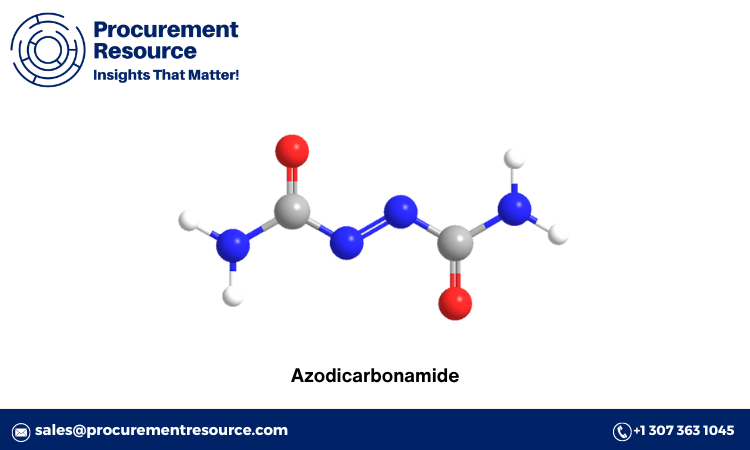Understanding the Azodicarbonamide Production Process: A Comprehensive Overview

Azodicarbonamide, commonly abbreviated as ADA, is a chemical compound predominantly used in the manufacturing of foamed plastics and as a food additive. Its role as a blowing agent in the plastic industry helps in creating a cellular structure in materials like PVC and EVA, leading to lightweight and flexible end products. In the food industry, it is known for its use as a flour bleaching agent and improving the texture of dough. This compound, though controversial in some applications, plays a vital role in modern manufacturing processes.
The production of Azodicarbonamide involves a series of chemical reactions that transform the raw materials into a usable compound. The process is intricate, requiring precise control over various parameters to ensure the quality and safety of the final product. This blog delves into the production process, costs involved, and the latest developments in the industry.
Manufacturing Report and Process
The manufacturing process of Azodicarbonamide typically involves several stages, starting with the synthesis of the precursor compounds and culminating in the purification and packaging of the final product. Here is a detailed overview of the process:
Request For Sample: https://www.procurementresource.com/production-cost-report-store/azodicarbonamide/request-sample
-
Raw Material Preparation: The primary raw materials for producing ADA are urea, hydrazine hydrate, and sodium hypochlorite. These materials are carefully measured and prepared to ensure the correct stoichiometric ratios.
-
Synthesis Reaction: The process begins with the reaction between urea and hydrazine hydrate to form biurea. This reaction is conducted in a reactor vessel under controlled conditions of temperature and pressure. The biurea is then oxidized using sodium hypochlorite, resulting in the formation of Azodicarbonamide.
-
Purification: The crude Azodicarbonamide produced in the synthesis reaction contains impurities that need to be removed. Purification involves recrystallization from a suitable solvent, usually water or an alcohol-water mixture. The product is then filtered, washed, and dried to obtain pure ADA.
-
Milling and Packaging: The purified ADA is milled to achieve the desired particle size distribution. This step is crucial for ensuring the uniformity and effectiveness of the compound when used in various applications. Finally, the product is packaged in suitable containers, ready for distribution.
Raw Material Costs
The cost of raw materials is a significant component of the overall production cost of Azodicarbonamide. The primary raw materials used in its production are urea, hydrazine hydrate, and sodium hypochlorite. The prices of these chemicals can fluctuate based on various factors, including supply and demand dynamics, geopolitical events, and changes in production capacities.
-
Urea: Urea is a widely available chemical used in various industrial applications, including fertilizers. Its cost is influenced by the agricultural sector’s demand and the global supply of ammonia, which is a key feedstock for urea production.
-
Hydrazine Hydrate: This chemical is more specialized and can be more expensive than urea. The cost of hydrazine hydrate is affected by the availability of hydrazine, which is produced through the Raschig process or the peroxide process. Additionally, safety regulations and transportation costs can impact its price.
-
Sodium Hypochlorite: Commonly known as bleach, sodium hypochlorite is used in various cleaning and disinfection applications. Its cost is relatively stable but can vary depending on the availability of chlorine and caustic soda, which are used in its production.
In addition to these primary raw materials, other costs such as energy, labor, and maintenance also contribute to the overall production cost. Efficient management of these factors is crucial for maintaining profitability in Azodicarbonamide production.
Latest News
The production and use of Azodicarbonamide have been subjects of various discussions and developments in recent years. Here are some of the latest news and trends in the industry:
-
Regulatory Changes: Azodicarbonamide’s use as a food additive has been controversial due to potential health concerns. Several regulatory bodies, including the FDA and EFSA, have conducted studies to evaluate its safety. In some regions, its use in food products has been restricted or banned, leading to shifts in demand and production practices.
-
Sustainability Initiatives: The chemical industry is increasingly focusing on sustainability, and the production of Azodicarbonamide is no exception. Manufacturers are exploring greener synthesis methods, reducing waste, and improving energy efficiency to minimize the environmental impact of ADA production.
-
Market Dynamics: The demand for Azodicarbonamide in the plastics industry remains robust due to its effectiveness as a blowing agent. However, fluctuations in raw material prices and supply chain disruptions can affect production costs and market prices. Staying informed about these dynamics is crucial for manufacturers and consumers alike.
-
Technological Advancements: Advances in chemical engineering and process optimization are continuously improving the efficiency and safety of Azodicarbonamide production. Innovations such as automated control systems, improved reactor designs, and better purification techniques are helping manufacturers produce higher quality ADA at lower costs.
-
Health and Safety Concerns: Despite its widespread use, Azodicarbonamide has faced scrutiny regarding its potential health effects. Research is ongoing to better understand the implications of ADA exposure and to develop safer alternatives for applications where its use is deemed problematic.
Conclusion
The production of Azodicarbonamide is a complex process that requires careful management of raw materials, precise control over chemical reactions, and efficient purification techniques. Understanding the costs involved and staying abreast of the latest industry developments are essential for stakeholders in the ADA market.
With ongoing regulatory changes, sustainability initiatives, and technological advancements, the landscape of Azodicarbonamide production is continually evolving. By keeping informed about these trends and adapting to new challenges, manufacturers can ensure the continued success and growth of their operations in this dynamic industry.

